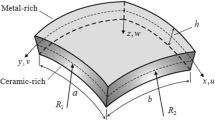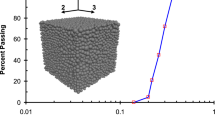Abstract
The analogy between structural progressive collapse and Fracture Mechanics is consistent either for phenomenological, technological and theoretical aspects. In this paper a general energy criterion suitable for fracture in heterogeneous materials is applied to study the progressive collapse of simple structures with cohesive post peak behavior: elementary frames and fiber bundles. The analyses put into evidence some interesting scale effects induced by ductility and dynamics. In particular, a power law describing the decrease of the reduced dynamic critical load with the structural scale and a second order ductile-brittle transition, have been found. These results can be usefully applied in robustness oriented structural design. Moreover, the study of the influence of the extent of the starting damage in structures with different sizes suggests that, the elementary cells of complex framed structures can play a role similar to the microstructure of materials. In conclusion, a new approach to the problem of collapse into complex structures by means of the tools of Fracture Mechanics is proposed.
Similar content being viewed by others
References
Bažant ZP (1984) Size effects in blunt fracture: concrete, rock, metal. J Eng Mech 110(4): 518–535
Bažant ZP (2004) Probability distribution of energetic-statistical size effect in quasibrittle fracture. Probab Eng Mech 19:307–319. doi:10.1016/j.probengmech.2003.09.003
Bažant ZP, Cedolin L (1991) Stability of structures: elastic, inelastic, fracture and damage theories. Oxford University Press, New York
Bažant ZP, Pang S-D (2007) Activation energy based extreme value statistics and size effect in brittle and quasibrittle fracture. J Mech Phys Solids 55:91–134. doi:10.1016/j.jmps.2006.05.007
Bažant ZP, Verdure M (2007) Mechanics of progressive collapse: learning from World Trade Center and building demolitions. J Eng Mech 133(3):308–319. doi:10.1061/(ASCE)0733-9399(2007)133:3(308)
Bažant ZP, Xi Y, Reid SG (1992) Statistical size effect in quasi-brittle structures: I. Is Weibull theory applicable? J Eng Mech 117(11):2609–2622. doi:10.1061/(ASCE)0733-9399(1991)117:11(2609)
Carpinteri A (1989) Decrease of apparent tensile and bending strength with specimen size: two different explanations based on fracture mechanics. Int J Solids Struct 25(4): 407–429. doi:10.1016/0020-7683(89)90056-5
Carpinteri A (1997) Structural mechanics: a unified approach. Chapman & Hall, London
Carpinteri A, Chiaia BM (1995) Multifractal nature of concrete fracture surfaces and size effects on nominal fracture energy. Mater Struct 28(182):435–443. doi:10.1007/BF02473162
Carpinteri A, Chiaia BM, Ferro G (1995) Size effects on nominal strength of concrete structures: multifractality of material ligaments and dimensional transitino from order to disorder. Mater Struct 28(180): 311–317. doi:10.1007/BF02473145
Carpinteri A, Corrado M, Paggi M et al (2007) Cohesive versus overlapping crack model for a size effect analysis of RC elements in bending. In: Carpinteri A, Gambarova P, Ferro G, Plizzari G (eds) Fracture mechanics of concrete structures (Proceedings of the 6th International FraMCoS Conference, Catania, Italy 2007). Taylor & Francis, London, Vol II, pp 655–663
Chiaia BM, Masoero E (2007) Structural robustness: the role of geometry and complexity and the brittle fracture analogy. Paper presented at the 18th congress of the Italian Association of Theoretical and Applied Mechanics AIMETA, University of Brescia, 11–14 September 2007
Chiaia BM, Vervuurt A, Van Mier JGM (1997) Lattice model evaluation of progressive failure in disordered particle composites. Eng Fract Mech 57(2/3): 301–318. doi:10.1016/S0013-7944(97)00011-8
Fantilli AP, Iori I, Vallini P (2007) Size effects of compressed concrete in four point bending RC beams. Eng Fract Mech 74:97–108. doi:10.1016/j.engfracmech.2006.01.013
Gibson LJ, Ashby MF (1997) Cellular solids. Structure and properties, 2nd edn. Cambridge University Press, UK
Griffith AA (1921) The phenomena of rupture and flow in solids. Philos T R Soc A 221:163–198. doi:10.1098/rsta.1921.0006
Harlow DG, Phoenix SL (1978) The chain-of-bundles probability model for the strength of fibrous materials I: Analysis and Conjectures. J Compos Mater 12(2):195–214. doi:10.1177/002199837801200207
Herrmann, HJ, Roux, S (eds) (1990) Statistical models for the fracture of disordered media. North-Holland, Amsterdam
Herrmann HJ, Hansen A, Roux S (1989) Fracture of disordered, elastic lattices in two dimensions. Phys Rev B 39:637–648. doi:10.1103/PhysRevB.39.637
Hillerborg A, Modéer N et al (1976) Analysis of crack formation and crack growth in concrete by means of fracture mechanics and finite elements. Cement Concr Res 6: 773–782. doi:10.1016/0008-8846(76)90007-7
Kim DY, Herrmann HJ, Landau DP (1987) Percolation on a random lattice. Phys Rev B 35:3661–3662. doi:10.1103/PhysRevB.35.3661
Levy M, Salvadori M (1994) Why buildings fall down: why structures fail. W.W. Norton & Company, New York, USA
Maes MA, Fritzsons K, et al (2006) Structural robustness in the light of risk and consequences analysis. Struct Eng Int 2:101–107. doi:10.2749/101686606777962468
Matuttis HG, Luding S, Herrmann HJ (2000) Discrete Elements simulations of dense packing and heaps made of spherical and non-spherical particles. Powder Technol 109:278–292. doi:10.1016/S0032-5910(99)00243-0
Pretlove AJ, Ramsden M, Atkins AG (1991) Dynamic effects in progressive failure of structures. Int J Impact Eng 11(4): 539–546. doi:10.1016/0734-743X(91)90019-C
RILEM TC QFS (chaired by Bažant ZP) (2004) Quasibrittle fracture scaling and size effect—final report. Mater Struct 37(272), 547–586
Schlangen E, Van Mier JGM (1993) Lattice model for simulating fracture of concrete. In: Wittmann FH(eds) Numerical models in fracture mechanics of concrete. Balkema, Rotterdam, pp 195–205
Sih GC, Hartranft RJ (1980) The concept of fracture mechanics applied to the progressive failure of structural members. Comput Struc 12: 813–818. doi:10.1016/0045-7949(80)90018-8
Smith JW (2006) Structural robustness analysis and the fast fracture analogy. Struct Eng Int 2:118–123. doi:10.2749/101686606777962521
Sorensen JD, Christensen HH (2006) Danish requirements for robustness of structures: background and implementation. Struct Eng Int 2:172–177. doi:10.2749/101686606777962576
Val DV, Val EG (2006) Robustness of frame structures. Struct Eng Int 2: 108–112. doi:10.2749/101686606777962413
Van Mier JGM, Chiaia BM, Vervuurt A (1997) Numerical simulation of chaotic and self-organized damage in brittle disordered materials. Comput Methods Appl M 142:189–201. doi:10.1016/S0045-7825(96)01128-0
Vermeer PA, Diebels S, Ehlers W, Herrmann HJ, Luding S, Ramm E (2001) Continuous and discontinuous modeling of cohesive-frictional materials. Springer-Verlag, Berlin Heidelberg New York
Author information
Authors and Affiliations
Corresponding author
Rights and permissions
About this article
Cite this article
Chiaia, B.M., Masoero, E. Analogies between progressive collapse of structures and fracture of materials. Int J Fract 154, 177–193 (2008). https://doi.org/10.1007/s10704-008-9287-2
Received:
Accepted:
Published:
Issue Date:
DOI: https://doi.org/10.1007/s10704-008-9287-2




